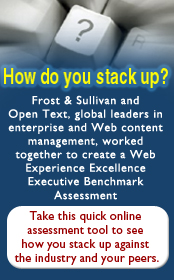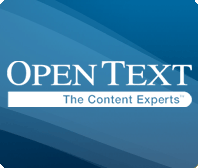| |
 |
|
JUNE
2010 | VOL. 3 | ISSUE 1 |
|
CONNECT |
 |
 |
 |
 |
|
|
 
STRATEGY SESSION
The Gift of Resource Scarcity?
 |
|
|
By Dr. Damian Saccocio
Vice President
Solutions Marketing and Strategy
Enterprise 2.0 Line of Business
Open Text
|
|
We all live in organizations with finite resources but I was reminded of how scarcity can sometimes be a virtue at a recent technology conference in New York. There, with many of the biggest consumer brands in attendance, the challenges discussed were often not about technology but rather, organizational and political. This was striking because the focus of the event was software to help manage content--rich media content in particular.
It was only a few years ago when digital media technology was a dark art where wizards oversaw a cauldron of file formats, compression algorithms and rights regimes. Today, however, it’s fair to say that most all content workflows at most all organizations are most(ly) digital. This increasingly includes rich media workflows associated with presentations, photos and video. The features of the necessary IT software tools to facilitate digital content workflows are now largely well defined and specifiable. This maturation of the technology has moved the focus away from whether a particular software application can do a particular task (e.g. transformation, rendering, etc.), and toward how easily and quickly a particular application can be made to work with other software tools in the customer’s digital ecosystem.
That’s all well and good, but while vendors and systems integrators can now much more easily put together systems customized for specific needs, the biggest obstacle can frequently be the will or interest to actually integrate systems across organizational units. The irony is that this seems to be a bigger challenge at enterprises that initially had the where-with-all to develop separate solutions for specific units.
Organizations that were obliged to share centralized IT systems from the start (e.g. a common Web content management system) are now in a position to more readily exploit the advantages of a hub and spoke system with common repositories and shared metadata models. The potential benefits go beyond lowering overall TCO (total cost of ownership) and often include enhanced business agility, greater content creation productivity, and enhanced control and compliance.
Business agility can be seen in how rapidly a well-received marketing campaign or service innovation can be replicated across an organization. When sister divisions or business units are on different IT infrastructures, the time spent coordinating access and sharing knowledge can easily stretch the replication period such that the costs now outweigh the expected benefits.
Speaking of costs, rich media creation can be a sore spot in anyone’s budget during these economic times. Ensuring that one’s organization is taking full advantage of the creative assets already created or purchased is job No. 1. Just finding relevant content can be a core challenge with separate IT systems. Many companies have found that their decrease in spending on professional photography and video can in itself justify an investment in a centralized media management system.
And while we all appreciate the imperative to operate globally, the ability to localize content is entirely dependent on knowing when and how to stay within enterprise guidelines. I have personally seen this trend manifested among many modest-sized non-profit organizations with widely dispersed global field operations. These organizations have invested in centralized media management systems specifically to empower their global operations to not only distribute content, but to ingest and report back on the effects of the work so that their funders can see results.
So if you find you’re within an organization with scarce resources (and who isn’t these days), the silver lining of that cloud can be the motivation to share IT systems – not only can this lead to cost savings, but may well put your enterprise in a position to move faster, with less cost, and greater control than your better resourced competitors. And while perhaps not a gift per se, with a bit of planning and the right tools, scarcity can sometimes be turned to your advantage when it comes to managing today’s digital content and rich media workflows.
|
|
|
|
| |
|
|
|
|
PRIVACY POLICY: We are committed to protecting your right to privacy. © 2010 Frost & Sullivan
This message was sent to you by Frost & Sullivan, 7550 IH 10 W, Ste. 400, San Antonio, TX 78229. If you would prefer not to receive further messages from this sender, please click here or reply to this email and place the word REMOVE in the subject line.
|
|
{OPENEDEMAILMARKER} |
|






